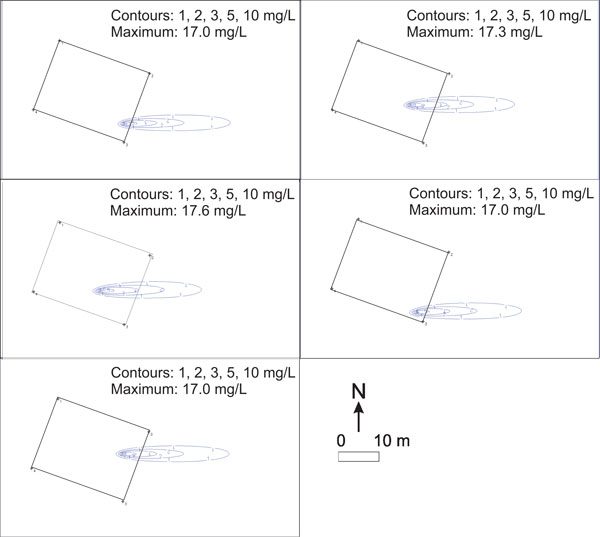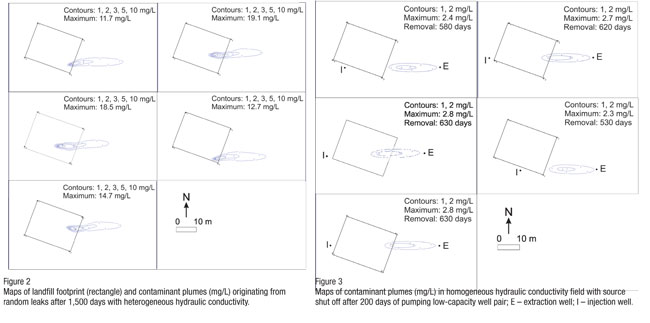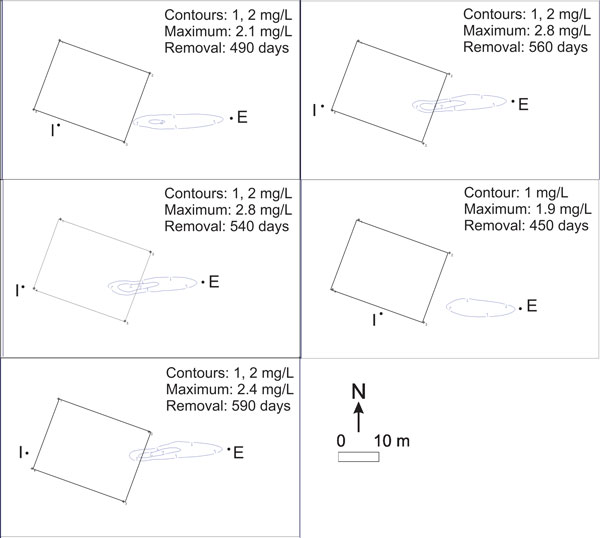Examining the potential viability of natural attenuation and low-capacity well pairs for removing narrow leachate plumes originating from lined landfills.
By Paul F. Hudak
Solid waste impoundments often pollute groundwater. Both older, poorly contained landfills and contemporary landfills may release leachate to the subsurface. Leachate passes through small holes or tears in liners beneath modern landfills. Timely source and control and mitigation can prevent widespread contamination from leaking landfills. Cost and timeframe are important considerations for aquifer remediation. Passive approaches to remediation involving small inputs of energy have become popular over the past decade.
Passive remediation approaches include trenches or wells filled with reactive media placed downgradient of contaminant plumes.1,2,3 Ideally, natural groundwater flow carries dissolved contaminants to the structure containing reactive media.4 However, high excavation and maintenance costs limit the application of filled trenches in practice. Wells are less costly, access deeper intervals, and can also be installed in various orientations,5 but tend to have small capture zones and short contact times with contaminants.6 Filter media in passive wells or trenches can remove some, but not all of the numerous contaminants in landfill leachate.
Alternatively, low-capacity extraction-injection well pairs powered with small amounts of solar electricity may be capable of removing relatively narrow contaminant plumes in groundwater. In this case, a well pair consists of a downgradient extraction well linked to an upgradient injection well through above-ground piping and treatment equipment. Although low-capacity wells have narrow capture zones, they are wider than those induced by passive wells, and might work for narrow contaminant plumes. Narrow, fingering plumes are more typical of small holes or tears in synthetic liners.7 Well pairs allow for more controlled, above-ground treatment capable of handling a wider range of contaminants than reactive media in passive wells or trenches. Injection wells hasten the remediation process by increasing hydraulic gradients toward the extraction well.
Natural attenuation (dilution and hydrodynamic dispersion) takes place with or without pumping wells, contributing to the overall remediation process. This study examined the capability of natural attenuation and low-capacity well pairs to remove narrow contaminant plumes originating from a lined landfill.
Methods
MT3DMS8 was used to simulate groundwater flow and mass transport in an unconfined aquifer beneath a hypothetical, lined waste impoundment (Figure 1). In this application, the finite-difference grid consisted of 150,000 cells, with 300 rows oriented east-west and 500 columns trending north-south. Nodes in cell centers were 0.15 m apart along rows and columns. Hydraulic head was constant at 5.0000 m and 4.2515 m at the westernmost and easternmost columns of nodes, respectively. These values were measured from a datum of 0 m at the bottom of the model. The hydraulic gradient averaged 0.01 eastward across the model. No flow crossed the northern, southern or bottom edges of the model.

Maps of landfill footprint (rectangle) and contaminant plumes (mg/L) originating from random leaks after 1,500 days with
Both homogeneous and heterogeneous hydraulic conductivity fields were input to the model in different simulations. In homogeneous cases, hydraulic conductivity equaled 0.5 m/day. For heterogeneous simulations, a random hydraulic conductivity matrix was obtained from a distribution (log10, m/day) with a mean of -0.301 and standard deviation of 0.18. The correlation length of hydraulic conductivity in the random matrix equaled 2 m.
Other models parameters were representative of alluvium documented in the literature:9,10,11 effective porosity = 0.25, longitudinal dispersivity = 1.0 m, transverse dispersivity = 0.1 m, and effective molecular diffusion coefficient = 0.00001 m2/day.
A random number generator identified five leak locations in the footprint of the landfill (Figure 1). For each release, the model produced a contaminant plume for the homogeneous and heterogeneous hydraulic conductivity fields. Leakage (recharge) rates were 0.1 m/day with a concentration of 100 mg/L over a time period of 1,500 days. No recharge occurred over the remainder of the landfill’s footprint. Outside the landfill, the recharge rate equaled 0.0003 m/day. Contaminant plumes had a boundary value of 1.0 mg/L.
The point source was terminated in subsequent remediation simulations. Two alternatives were simulated for each contaminant plume: passive remediation (dilution and hydrodynamic dispersion); and an extraction-injection well pair, with each well pumping at 1 m3/day. The extraction well was placed at the downgradient tip of a contaminant plume. Extracted water was considered treated above ground and pumped into the injection well. The injection well was placed upgradient of the contaminant plume and 3 m upgradient of the landfill.
A remediation alternative was considered successful if it contained and removed the contaminant plume. Containment meant that concentrations did not reach 1.0 mg/L at any of the easternmost column of nodes. Model output was also studied to determine the amount of time necessary to remove a plume, meaning contaminant levels dropped below 1 mg/L at all model cells. The preconditioned and generalized conjugate gradient solvers8 were used in groundwater flow and mass transport simulations, respectively. Mass balance errors were less than 0.03 percent.
Results and Discussion
Figure 1 shows contaminant plumes generated for the homogeneous hydraulic field. Given a 0.15 m node spacing, source areas were small and produced narrow contaminant plumes. These plumes had smooth boundaries but were not quite symmetrical about the long axis due to spatial variation in aquifer recharge, particularly across the landfill’s footprint. Contaminant plumes were similar in shape, with those originating farther downgradient moving closer to the eastern boundary of the model domain.
The heterogeneous hydraulic conductivity field produced a more complex flow pattern, with convergence or divergence into zones of relatively high or low hydraulic conductivity, respectively. Contaminant plumes evolving in the more complex, heterogeneous flow field showed more variability in size, shape and maximum concentration (Figure 2).

With the source shut off, natural attenuation effectively removed each contaminant plume in the homogeneous and heterogeneous cases. The amount of time required to remove a plume ranged from 1,130 to 1,330 days in the homogeneous aquifer (Figure 1, left to right along rows: 1,130, 1,240, 1,330, 1,170, and 1,150 days). In the heterogeneous aquifer, the removal period ranged from 960 to 1,160 days (Figure 2, left to right along rows: 960, 1,110, 1,160, 1,000, and 1,100 days). Thus, dilution and hydrodynamic dispersion in the onsite buffer zone—beyond the landfill’s footprint, but within the model domain—effectively lowered the 100 mg/L source concentration to less than 1.0 mg/L.
Alternatively, low-capacity well pairs contained contaminant plumes while also shortening removal timeframe. After 200 days of pumping, contaminant plumes in the homogeneous aquifer remained upgradient of the extraction well (Figure 3, page 55). The amount of time necessary to remove a plume ranged from 530 days for the point source closest to the landfill’s downgradient edge, to 630 days for a plume originating farther upgradient in the landfill. Less dilution by recharge beneath the landfill slightly increased remediation timeframe for more upgradient contaminant plumes.
Under active remediation in the heterogeneous aquifer, contaminant plumes continued to show irregular form and more variability in size after 200 days, reflecting variability in the hydraulic conductivity field (Figure 4). Some of these plumes took more time to remove, and some less time, than plumes from corresponding point sources in the homogeneous aquifer. Overall, timeframe for removal ranged from 450 to 590 days in the heterogeneous aquifer, reflecting variation in the hydraulic conductivity field, especially the portion of the field between the contaminant plume and extraction well.
Results outlined above suggest that natural attenuation and low-capacity well pairs in onsite buffer zones may be effective remediation alternatives in some homogeneous and heterogeneous settings. Strategically designed extraction-injection well pairs shorten remediation timeframe.

Maps of contaminant plumes (mg/L) in heterogeneous hydraulic conductivity field with source shut off after 200 days of pumping low-capacity well pair; E – extraction well; I – injection well.
Well placements different than those examined here might also be viable in some settings; however, extraction wells placed inside a contaminant plume must work against the prevailing hydraulic gradient to remove the downgradient portion of the plume. Conversely, placing a well too far downgradient of a contaminant plume stretches the plume and contaminates clean aquifer, while simultaneously increasing the risk of pulling in offsite contaminants. Ideally, for the design strategy considered here, injection wells should be upgradient, but close to a contaminant plume. In this application, injection wells were also placed upgradient of the landfill, reflecting the practical need to avoid drilling through a landfill, as doing so would entail safety hazards and compromise the containment structure. Wider capture zones might be achievable by putting both the extraction and injection well downgradient of a contaminant plume, aligning them perpendicular to the hydraulic gradient, though this orientation may require a higher pumping rate.12
In practice, site-specific conditions should strongly influence remediation protocol, such as placement and pumping rates for low-capacity well pairs if that alternative is being considered. Some conditions would not be suitable for low-capacity well pairs, including very wide contaminant plumes, low-solubility contaminants and low groundwater seepage rates. Low-capacity wells have narrow capture zones suited to narrow plumes. Low solubility and seepage rates would prevent or delay movement of contaminants to the extraction well.
Conclusion
This study examined the potential viability of natural attenuation and low-capacity well pairs for removing narrow leachate plumes originating from lined landfills. For the parameters examined here, both alternatives effectively contained and removed contaminant plumes in simulated homogeneous and heterogeneous aquifers. Adding a low-capacity well pair significantly shortened remediation timeframe. These techniques may be suitable at some sites, for which they should be considered as a remediation option. | WA
Paul F. Hudak is a professor in the Department of Geography and the Environment at the University of North Texas (Denton, TX). He received a B.S. in geology from Allegheny College, M.S. in geology from Wright State University, and Ph.D. in geography, emphasis in water resources, from the University of California, Santa Barbara. He has also practiced geotechnical consulting in Pennsylvania, Ohio, California, and Texas. His current research interests include groundwater monitoring and remediation, geologic hazards, urban heat islands, and wetland mitigation. He can be reached at [email protected].
Notes
USGS (U.S. Geological Survey) 1999. Deep aquifer remediation tools (DARTs): A new technology for ground-water remediation. U.S. Geological Survey Fact Sheet 156- 99. U.S. Geological Survey, Reston, Virginia.
Richardson, J.P. and Nicklow, J.W. 2002. In situ permeable reactive barriers for groundwater contamination. Soil and Sediment Contamination: An International Journal, 11(2), 241-268.
Wilkin, R.T., Acree, S.D., Ross, R.R., Puls, R.W., Lee, T.R., and Woods, L.L. 2014. Fifteen-year assessment of a permeable reactive barrier for treatment of chromate and trichlorotheylene in groundwater. Science of the Total Environment, 468-469, 186-195
Gavaskar, A.R. 1999. Design and construction techniques for permeable reactive barriers. Journal of Hazardous Materials, 68(1-2), 41-71.
Divine, C.E., Roth, T., Crimi, M., DiMarco, A.C., Spurlin, M., Gillow, J., and Leone, G. 2018. Ground Water Monitoring and Remediation, 38(1), 56-65.
Hudak, P.F. 2013. Shallow, non-pumped wells: A low-energy alternative for cleaning polluted groundwater. Bulletin of Environmental Contamination and Toxicology, 91(1), 107-110.
Lee, G.F. and Jones-Lee, A.J. 1994. A groundwater protection strategy for lined landfills. Environmental Science and Technology, 28(13), 584A-585A.
Zheng, C. and Wang, P.P. 1999. MT3DMS, A Modular Three-Dimensional Multi- Species Transport Model for Simulation of Advection, Dispersion and Chemical Reactions of Contaminants in Groundwater Systems; Documentation and User’s Guide. U.S. Army Engineer Research and Development Center, Contract Report SERDP-99-1. U.S. Army Corps of Engineers, Vicksburg, Mississippi.
API (American Petroleum Institute) 1989. Hydrogeologic Database for Groundwater Modeling. American Petroleum Institute, Washington, D.C.
Gelhar, L.W., Welty, C., and Rehfeldt, K.R. 1992. A critical review of data on field- scale dispersion in aquifers. Water Resources Research, 28(7), 1955-1974.
Fetter, C.W. 1994. Applied Hydrogeology. Macmillan, New York.
Cunningham, J.A. and Reinhard, M. 2002. Injection-extraction treatment well pairs: An alternative to permeable reactive barriers. Ground Water, 40(6), 599-607.
